Page 4120 of 4264
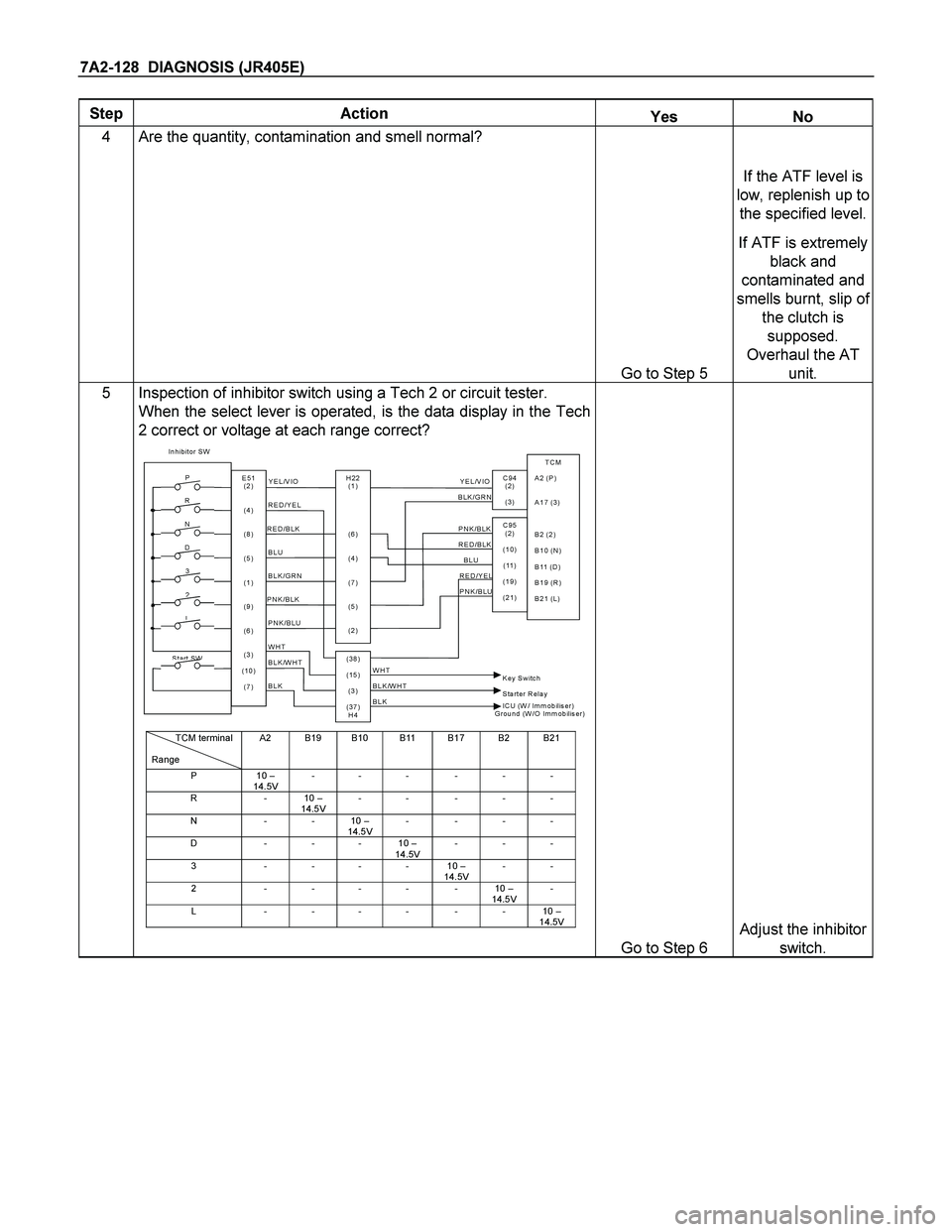
7A2-128 DIAGNOSIS (JR405E)
Step Action Yes No
4 Are the quantity, contamination and smell normal?
If the ATF level is
low, replenish up to
the specified level.
Go to Step 5
If ATF is extremely
black and
contaminated and
smells burnt, slip of
the clutch is
supposed.
Overhaul the AT
unit.
5 Inspection of inhibitor switch using a Tech 2 or circuit tester.
When the select lever is operated, is the data display in the Tech
2 correct or voltage at each range correct?
Inhibitor SW
TCM
A2 (P)
A17 (3)
B2 (2)
B10 (N)
B11 (D)
B19 (R)
B21 (L)
C95
(2 )
(10)
(11 )
(19)
(21) Y E L /V IO
RED/BLK
BLUBLK/GRN
Starter Relay
C94
(2 )
(3 )
BH22
(1)
(6)
(4)
(7)
(5)
(2) P
2
R
N
D
3
L
Start SW
PNK/BLU
E51
(2)
(4)
(8)
(5)
(1)
(9)
(6)
(3)
(10)
(7)
(38)
(15)
(3)
(37)
H4PNK/BLK
RED/YEL Y E L /V IO
BLK/GRN
PNK/BLK RED/BLK
BLU RED/YEL
PNK/BLU
BLK/WHT
BLK
BLK BLK/WHT Key Switch WHT
WHT
ICU (W/ Immobilis e r)
Ground (W/O Immobilis e r)
TCM terminal
RangeA2 B19 B10 B11 B17 B2 B21
P10 –
14.5V-- - - - -
R-10 –
14.5V-- ---
N--10 –
14.5V----
D - - - 10 –
14.5V---
3----10 –
14.5V--
2-----10 –
14.5V-
L------10 –
14.5V
Go to Step 6
Adjust the inhibitor
switch.
Page 4122 of 4264

7A2-130 DIAGNOSIS (JR405E)
No. F2: Engine Races Up During Acceleration (Slip)
Description:
� The engine speed up when the accelerator pedal is stepped on for acceleration and the gear is shifted up or
down.
� Only the engine speeds up but vehicle speed does not increase when the accelerator pedal is stepped on for
acceleration during the running.
Diagnosis Hints:
� Basically same causes as "No. C1 - C8: Engine races up (slip) by shift up or shift down" are considered.
When the condition of No. C1-C8 grows worse, symptom of No. F2 results.
No. F3: Noise or Vibration During the Running in R, D, 3, 2 or L Range
Description:
� Noise or vibration is generated in the vicinity of AT during the running.
Diagnosis Hints:
� Cause other than AT can be also considered. It is effective means to reproduce a running condition using a lift
up, chassis dynamo, etc. to investigate the origin (generating condition) of noise and vibration.
Caution:
Lifting up some unit to test it accompanies danger. Provide safety measures as far as possible and
carry out the test with sufficient care.
Possible Cause:
Following sources of noise or vibration other than the AT can be considered.
� Noise from differential gears.
� Noise from propeller shaft.
� The bearing support in the middle of the propeller shaft has fatigued, and the bend angle of the propeller shaft
has changed, causing vibration at the time of start.
� Unbalanced and poor uniformity of tires cause vibration.
No. F4: Engine Brake Does Not Apply in L Range
Description:
� The engine brake does not apply, allowing the vehicle to run freely when the accelerator pedal is released at low
speed in L range.
Possible Cause:
� Slip of clutch (low & reverse brake)
If slip of clutch is caused, a DTC (gear ratio error) is stored.
� Faulty input/output signal system.
Low & reverse brake duty solenoid
� Faulty control valve (faulty operation, sticking).
Page 4124 of 4264
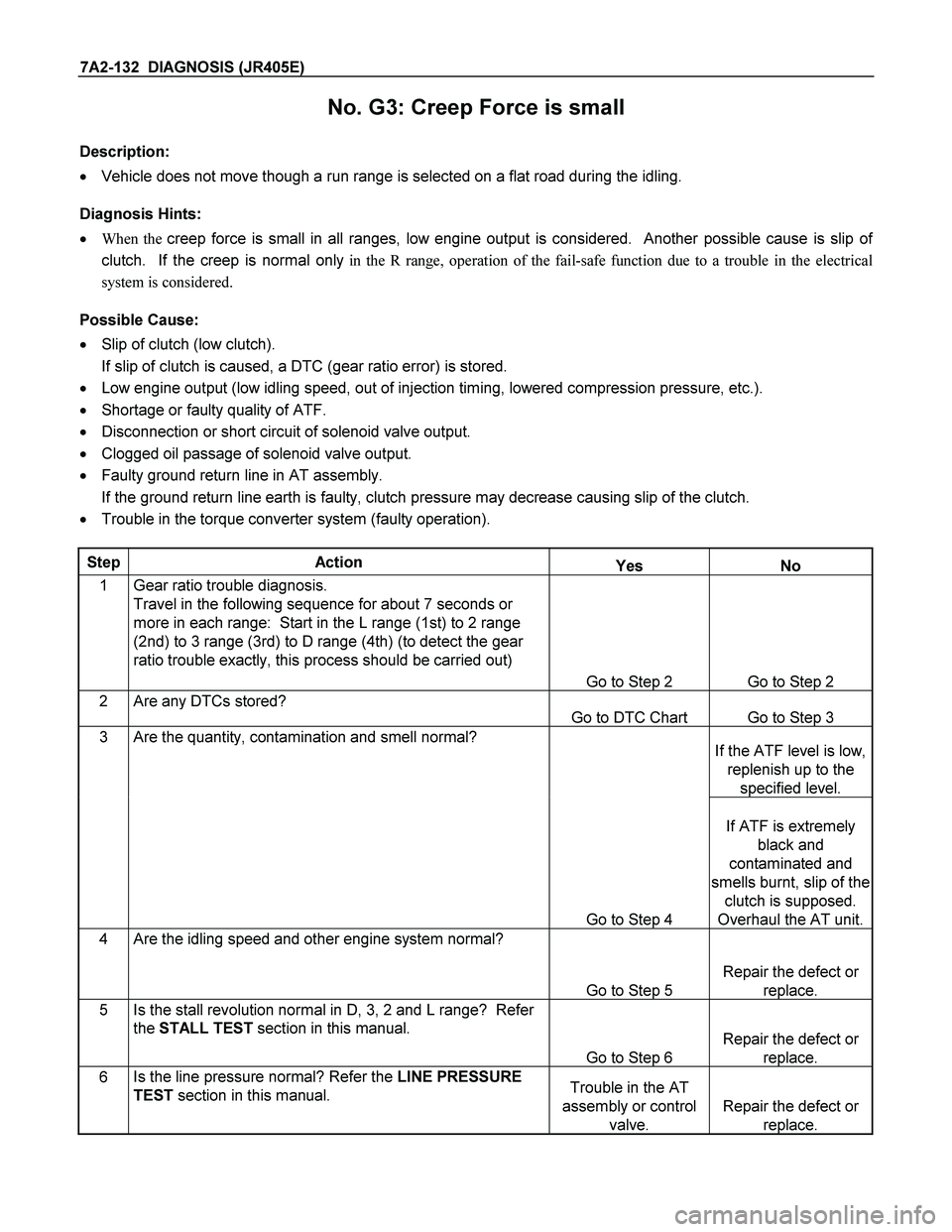
7A2-132 DIAGNOSIS (JR405E)
No. G3: Creep Force is small
Description:
� Vehicle does not move though a run range is selected on a flat road during the idling.
Diagnosis Hints:
� When the creep force is small in all ranges, low engine output is considered. Another possible cause is slip of
clutch. If the creep is normal only in the R range, operation of the fail-safe function due to a trouble in the electrical
system is considered.
Possible Cause:
� Slip of clutch (low clutch).
If slip of clutch is caused, a DTC (gear ratio error) is stored.
� Low engine output (low idling speed, out of injection timing, lowered compression pressure, etc.).
� Shortage or faulty quality of ATF.
� Disconnection or short circuit of solenoid valve output.
� Clogged oil passage of solenoid valve output.
� Faulty ground return line in AT assembly.
If the ground return line earth is faulty, clutch pressure may decrease causing slip of the clutch.
� Trouble in the torque converter system (faulty operation).
Step Action Yes No
1 Gear ratio trouble diagnosis.
Travel in the following sequence for about 7 seconds or
more in each range: Start in the L range (1st) to 2 range
(2nd) to 3 range (3rd) to D range (4th) (to detect the gear
ratio trouble exactly, this process should be carried out)
Go to Step 2 Go to Step 2
2 Are any DTCs stored?
Go to DTC Chart Go to Step 3
3 Are the quantity, contamination and smell normal? If the ATF level is low,
replenish up to the
specified level.
Go to Step 4
If ATF is extremely
black and
contaminated and
smells burnt, slip of the
clutch is supposed.
Overhaul the AT unit.
4 Are the idling speed and other engine system normal?
Go to Step 5
Repair the defect or
replace.
5 Is the stall revolution normal in D, 3, 2 and L range? Refer
the STALL TEST section in this manual.
Go to Step 6
Repair the defect or
replace.
6 Is the line pressure normal? Refer the LINE PRESSURE
TEST section in this manual. Trouble in the AT
assembly or control
valve.
Repair the defect or
replace.
Page 4126 of 4264

7A2-134 DIAGNOSIS (JR405E)
No. I1: No Lock-up
Description:
� Lockup is not performed in spite of the lock-up area.
Diagnosis:
� Lockup is not performed in spite of the lock-up area.
� Monitor the signal to the lock-up solenoid while carrying out a running test.
� When the output signal to the lock-up solenoid is correctly sent causing no lock-up, clogged lock-up solenoid oil
passage or malfunction of the lock-up piston may be considered.
� Even the lock-up area, the output signal to the lock-up solenoid is not sent, fault of the ATF thermo sensor
controlling the lockup is considered. (Lock-up is not operated at ATF temperature less than 11�C or more than
128�C.)
Note:
When the lock-up piston has burnt, foreign material mixed in the oil cooler is considered. In such a
case, inspect the oil cooler circuit for clogging of the oil cooler
Possible Cause:
� ATF thermo sensor detects low oil temperature (Lock-up is prohibited temperature less than 10�C.).
� Clogged oil passage of lock-up duty solenoid.
� Trouble in control valve body (faulty operation, sticking, clogged oil passage).
Step Action Yes No
1 Are any DTCs stored?
Go to DTC Chart Go to Step 2
2 Are the quantity, contamination and smell normal?
If the ATF level is
low, replenish up to
the specified level.
Go to Step 3
If ATF is extremely
black and
contaminated and
smells burnt, slip of
the clutch is
supposed.
Overhaul the AT
unit.
Page 4128 of 4264
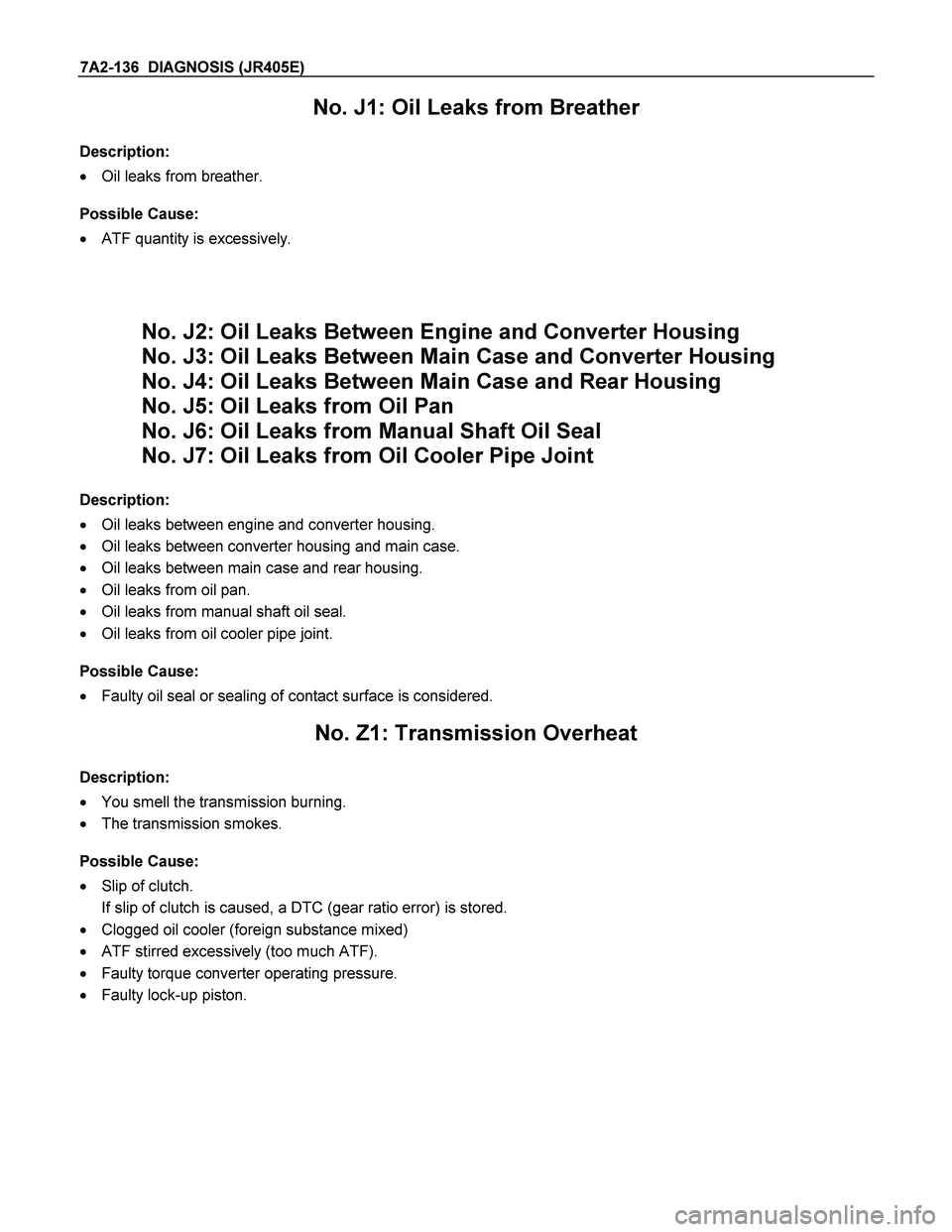
7A2-136 DIAGNOSIS (JR405E)
No. J1: Oil Leaks from Breather
Description:
� Oil leaks from breather.
Possible Cause:
� ATF quantity is excessively.
No. J2: Oil Leaks Between Engine and Converter Housing
No. J3: Oil Leaks Between Main Case and Converter Housing
No. J4: Oil Leaks Between Main Case and Rear Housing
No. J5: Oil Leaks from Oil Pan
No. J6: Oil Leaks from Manual Shaft Oil Seal
No. J7: Oil Leaks from Oil Cooler Pipe Joint
Description:
� Oil leaks between engine and converter housing.
� Oil leaks between converter housing and main case.
� Oil leaks between main case and rear housing.
� Oil leaks from oil pan.
� Oil leaks from manual shaft oil seal.
� Oil leaks from oil cooler pipe joint.
Possible Cause:
� Faulty oil seal or sealing of contact surface is considered.
No. Z1: Transmission Overheat
Description:
� You smell the transmission burning.
� The transmission smokes.
Possible Cause:
� Slip of clutch.
If slip of clutch is caused, a DTC (gear ratio error) is stored.
� Clogged oil cooler (foreign substance mixed)
� ATF stirred excessively (too much ATF).
� Faulty torque converter operating pressure.
� Faulty lock-up piston.
Page 4132 of 4264
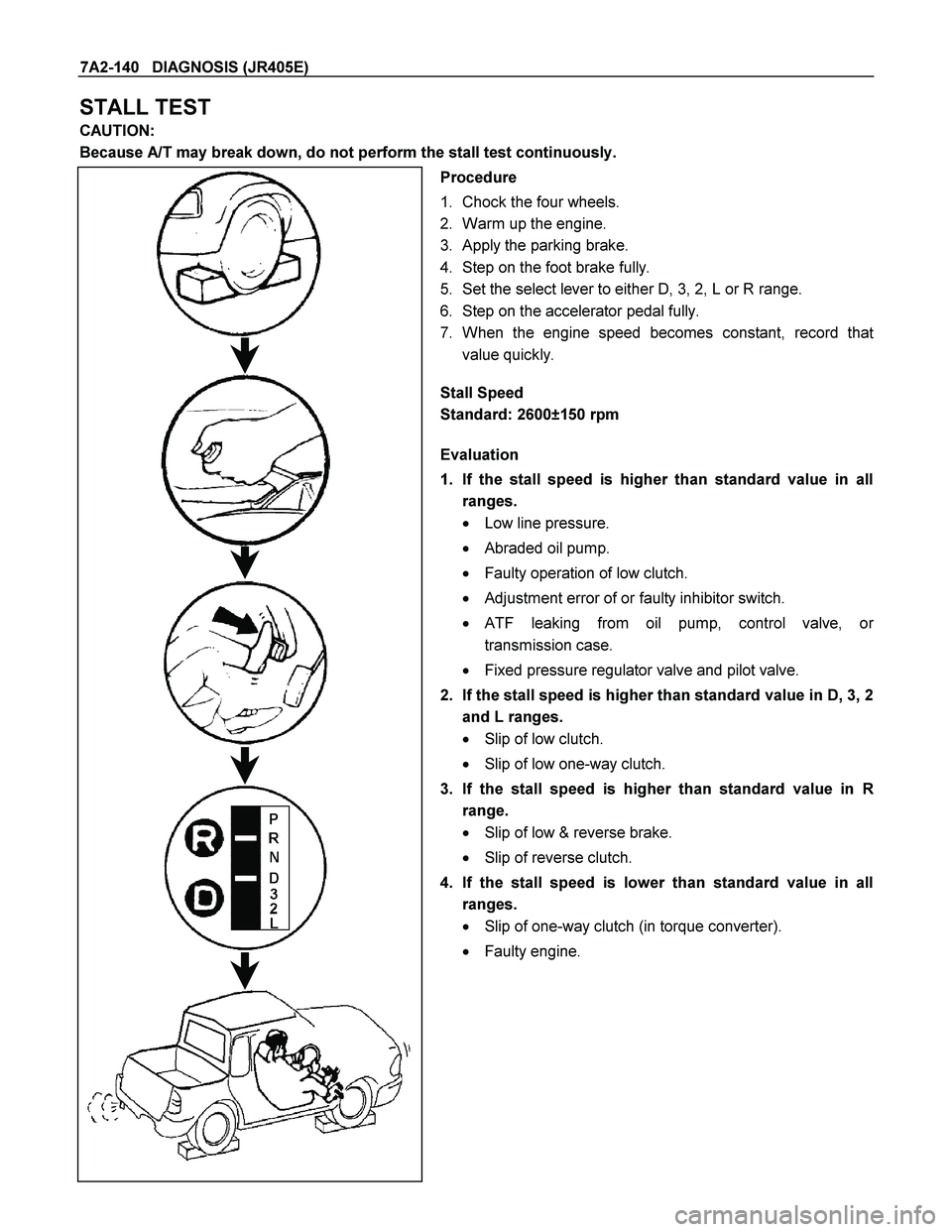
7A2-140 DIAGNOSIS (JR405E)
STALL TEST
CAUTION:
Because A/T may break down, do not perform the stall test continuously.
Procedure
1. Chock the four wheels.
2. Warm up the engine.
3. Apply the parking brake.
4. Step on the foot brake fully.
5. Set the select lever to either D, 3, 2, L or R range.
6. Step on the accelerator pedal fully.
7. When the engine speed becomes constant, record tha
t
value quickly.
Stall Speed
Standard: 2600±150 rpm
Evaluation
1. If the stall speed is higher than standard value in all
ranges.
� Low line pressure.
� Abraded oil pump.
� Faulty operation of low clutch.
� Adjustment error of or faulty inhibitor switch.
�
ATF leaking from oil pump, control valve, or
transmission case.
� Fixed pressure regulator valve and pilot valve.
2. If the stall speed is higher than standard value in D, 3, 2
and L ranges.
� Slip of low clutch.
� Slip of low one-way clutch.
3. If the stall speed is higher than standard value in
R
range.
� Slip of low & reverse brake.
� Slip of reverse clutch.
4. If the stall speed is lower than standard value in all
ranges.
� Slip of one-way clutch (in torque converter).
� Faulty engine.
Page 4133 of 4264
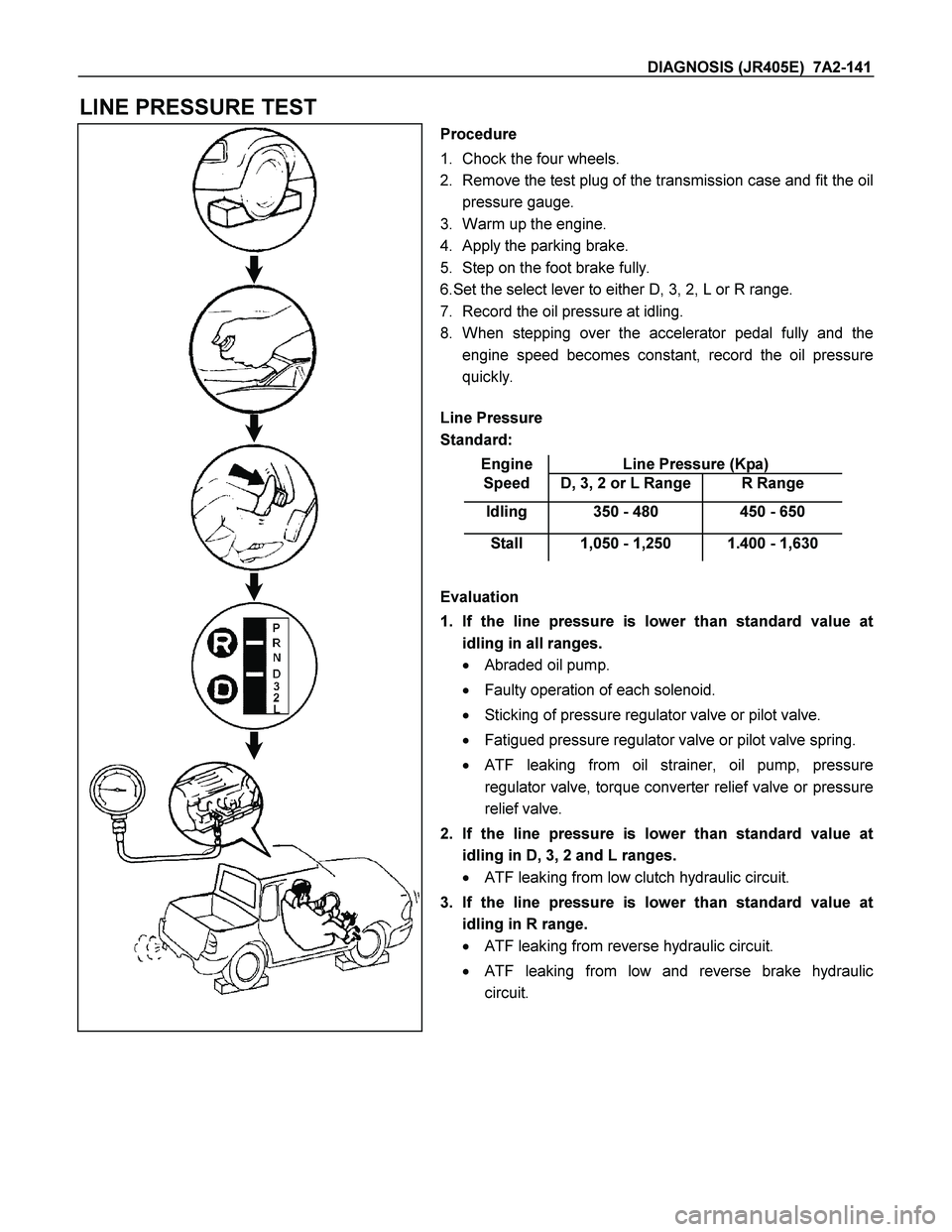
DIAGNOSIS (JR405E) 7A2-141
LINE PRESSURE TEST
Procedure
1. Chock the four wheels.
2. Remove the test plug of the transmission case and fit the oil
pressure gauge.
3. Warm up the engine.
4. Apply the parking brake.
5. Step on the foot brake fully.
6.Set the select lever to either D, 3, 2, L or R range.
7. Record the oil pressure at idling.
8. When stepping over the accelerator pedal fully and the
engine speed becomes constant, record the oil pressure
quickly.
Line Pressure
Standard:
Engine Line Pressure (Kpa)
Speed D, 3, 2 or L Range R Range
Idling 350 - 480 450 - 650
Stall 1,050 - 1,250 1.400 - 1,630
Evaluation
1. If the line pressure is lower than standard value at
idling in all ranges.
� Abraded oil pump.
� Faulty operation of each solenoid.
� Sticking of pressure regulator valve or pilot valve.
� Fatigued pressure regulator valve or pilot valve spring.
�
ATF leaking from oil strainer, oil pump, pressure
regulator valve, torque converter relief valve or pressure
relief valve.
2. If the line pressure is lower than standard value at
idling in D, 3, 2 and L ranges.
� ATF leaking from low clutch hydraulic circuit.
3. If the line pressure is lower than standard value at
idling in R range.
� ATF leaking from reverse hydraulic circuit.
� ATF leaking from low and reverse brake hydraulic
circuit.
Page 4134 of 4264
7A2-142 DIAGNOSIS (JR405E)
1. Oil Cooler Out
2. R Range Line Pressure Detection Port
(Low & Reverse Brake Pressure Detection Port)
3. D, 3, 2 & L Range Line Pressure Detection Port
(Low Clutch Pressure Detection Port)
4. Oil Cooler In
4. If the line pressure is lower than standard value at
idling in L and R ranges.
�
ATF leaking from low and reverse brake hydraulic
circuit.
5. If the line pressure is higher than standard value at
idling in all ranges.
� Throttle opening signal reception error.
� Faulty oil temperature sensor.
� Faulty operation of low clutch solenoid.
� Sticking pilot valve.
� Sticking pressure regulator valve or plug.
6. If the line pressure is lower than standard value at stall
speed in all ranges.
� Throttle opening signal reception error.
� Faulty operation of line pressure solenoid.
� Faulty operation of low clutch solenoid.
� Sticking pilot valve.
� Sticking pressure regulator valve or plug.